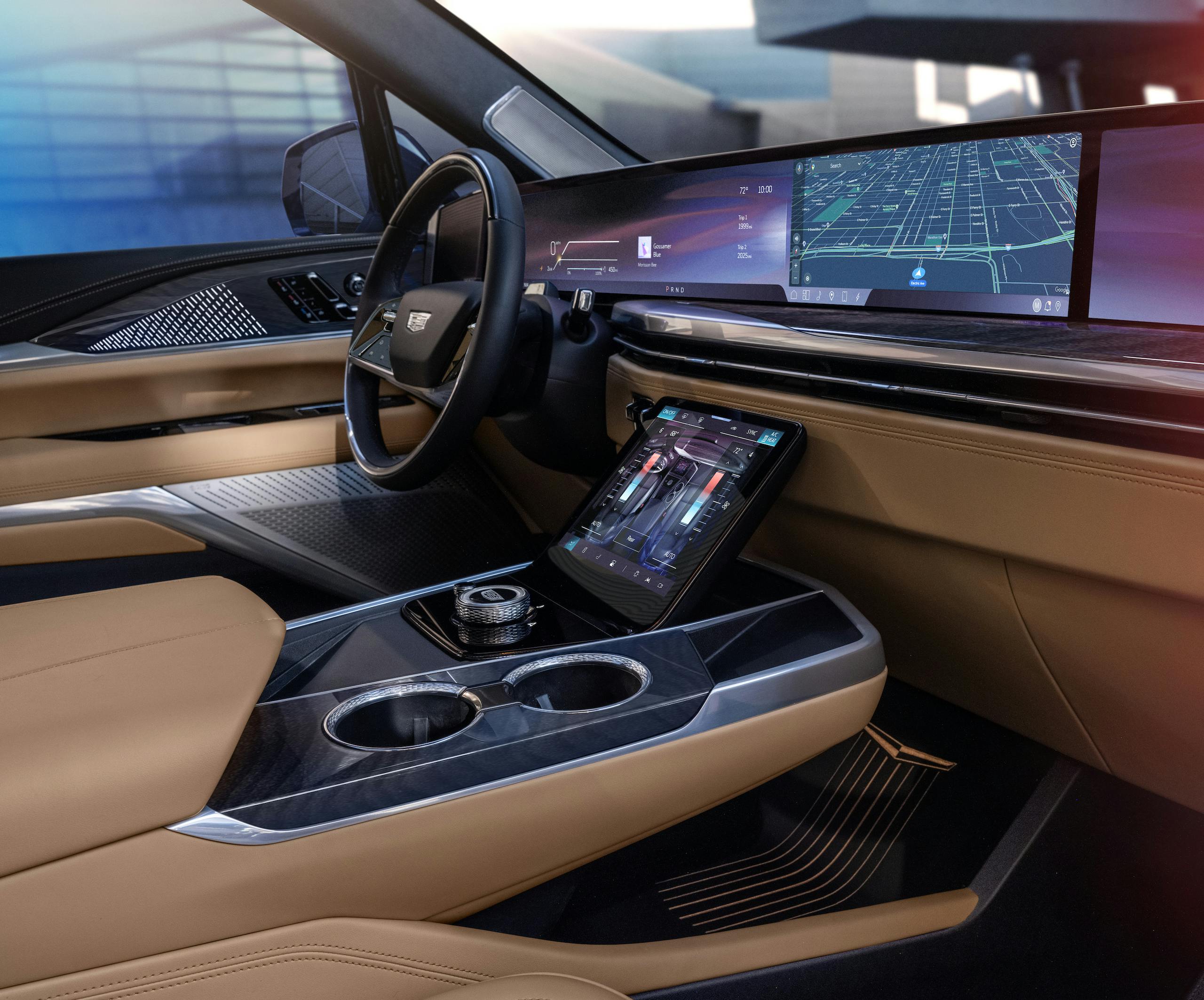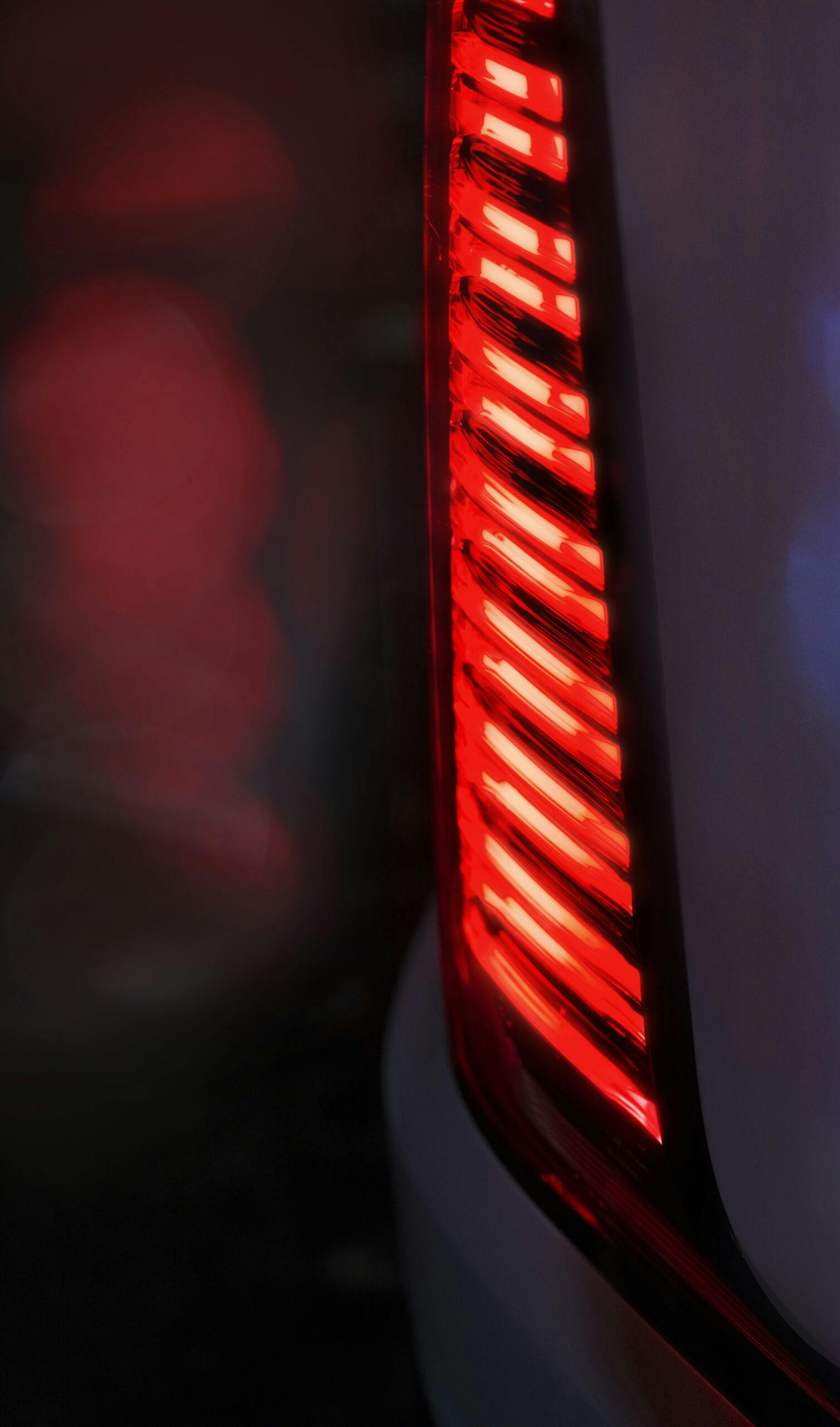Electric Escalade IQ brings familiar excess with new trappings
There is hardly a metric in which the battery-powered Escalade IQ does not challenge or surpass the engine-powered trucks: horsepower, price, wheel diameter, touchscreen pixels, turning radius, aerodynamic efficiency. For a few years, the electric- and the gas-powered trucks will even be sold side-by-side in Cadillac dealers, paving the way for the biggest question of all: Does the electric Escalade still say what an Escalade should say about the person driving it?
The Escalade first appeared in 1999 as, essentially, a Yukon Denali. Cadillac rebadged the GMC in an almighty rush, because the Lincoln Navigator, introduced for 1998, was selling better than anyone expected. So what if Cadillac wasn’t about SUVs? It was a company, and it needed to make money. Car and Driver received the first Escalade with mild confusion. Yes, it was luxurious, but it was expensive and flashy, more like a statement of prestige for prestige’s sake than a truly excellent automobile. Turns out, a statement was exactly what people wanted.
Cadillac has since updated the Escalade four times. The debut locations of each generation are telling: Pebble Beach, California; Beverly Hills; Miami, Florida; Beverly Hills, again. An Escalade is a vehicle you aspire to own, to be seen driving in the money-flashingest cities. One interior designer even admits that the model name has even superseded that of the manufacturer, which reveals the purity of the Escalade line as much as the hodgepodge that is the rest of Cadillac’s portfolio. Cadillac said in June of 2020 that all its electric models would carry names ending in “iq,” a promise it fulfilled with the Lyriq and the Celestiq. The Escalade name, however, carries so much cachet that Cadillac couldn’t afford to alter it, said that same designer. The company decided to simply tack on “IQ” as a sort of acronym after the familiar name.

The electric Escalade unveiled in New York City, in contrast to its forebears, is a clean-sheet design—unless, of course, you happen to look, yet again, at the GMC stable, to find that the powertrain is shared with the Hummer EV. Perhaps Cadillac should have picked another phrase, because what’s remarkable here is not what is novel but what is not: Visual cohesiveness with Cadillac’s other two electric vehicles, the $60K Lyriq and the $340K+ Celestiq, and even to Escalades with catalytic converters.
You notice the size first: The Escalade IQ is wider than its fossil-fuel siblings, and just about as tall, only three inches shorter than the long-wheelbase ESV. Then, you’ll start to notice what’s different: The roofline droops front to rear. The grille has LEDs instead of vents. Those hallmark horizontal taillights are now two-piece affairs.

Chenxing Yu, aerodynamics engineer for the Escalade IQ, says that, while her team was able to touch the vehicle “literally everywhere,” it had to play within a box; the electric truck had to look like an Escalade. It also had to hew to the language set by the Lyriq and Celestiq, which explains why those taillights, which house “piano key” LEDs under a clear lens with an aero-optimized, sharp trailing edge, had to be broken into top and bottom sections. It’s what the other IQ cars do.
Sometimes, Yu’s team spent months going back and forth with the design team on the shape of a single component: For instance, the applique on the side of the rear spoiler that connects the spoiler to the rear glass. Aero wanted it to be bigger, chunkier; design wanted it to be slimmer, sleeker. In other areas, design got its way: The wheels, for instance, which would measure no fewer than 24 inches in diameter.
All of these changes reflect a more aerodynamic SUV. For an EV, more aerodynamic efficiency places less drain on the batteries, yielding a longer range. (Cadillac estimates 450 miles, though you can expect the EPA rating to be a bit lower.) Engineers aren’t yet allowed to share the final drag coefficient, but the 15 percent gain compared to ICE Escalades is more pertinent anyways: You can only make a house so appealing to the air.
The interior design team got the fun job of picking from the catalog built for the Celestiq, though it had to work with a $130K rather than a $340K starting price. The massive, 55-inch dash-mounted touchscreen was an obvious include, but when the designers put it in the electric Escalade, they discovered it was too narrow to fill the cabin. To add length, the screen gained a speaker on each end.
Carrying over the Celestiq’s two-spoke steering wheel design was a simpler affair, as was the radar system in the doors that automatically opens them when an owner approached carrying the key fob. Rear-wheel steering is another shared feature, although the Escalade has one party trick the Celestiq doesn’t: Arrival Mode, which is Cadillac’s version of the Hummer’s Crab Walk, in which all wheels spin in the same direction to pivot the vehicle almost on a dime.
A 200-kWh battery pack capable of 800V charging sits between those wheels. (Good luck finding a station with that level of zap, though.) Each pair is driven by its own electric motor. Direct comparison with the most powerful of engine-powered Escalades requires a bit of qualification: The electric truck can temporarily, under V-Max mode, produce a scorching 750 hp and 785 lb-ft of torque. The power that’s available from the motors all of the time, no tricks needed, is 680 hp and 615 lb-ft of torque, figures that fall a little below those of the supercharged V-8 in the $150K, limited-production Escalade-V: 682 hp, 653 lb-ft of torque, as long as there’s gas in the tank.
Bench-race the V with the IQ however you will, because in power and in price the IQ model is clearly a different breed than the naturally aspirated Escalades: They produce 420 hp and 460 lb-ft of torque. Hardly embarrassing, especially if you want to spend less than six figures and say that you drive a new Escalade.

Towing capacity remains as high as it has ever been: 8000 pounds. Air suspension is still available, and especially welcome for its aerodynamic flexibility: At speed, the vehicle will hunker down to reduce drag and squeeze out a few more miles. The system is complemented by version 4.0 of GM’s Magnetic Ride Control. Super Cruise comes standard.
Cadillac will start building the Escalade IQ in the summer of 2025, when production will move from Texas to Michigan.
Can Detroit build an electric Escalade to eventually replace the gas-powered one? The jury’s out until we drive it, and even after then: As with the original Escalade, the journalistic verdict is no guarantee of success or failure; your judgment carries the most weight.
***
Check out the Hagerty Media homepage so you don’t miss a single story, or better yet, bookmark it. To get our best stories delivered right to your inbox, subscribe to our newsletters.





















8000 pound towing capacity… for how many miles?
This should have been the XT6 with ICE.
The debut locations: where conspicuous consumption and virtue signalling are of prime importance. As far as what it can do vs internal-combustion comparisons ? It can have more operational issues, greater repair expense, and less flexibility on longer trips. But at least it’s imposing, overweight, and entertaining for people who don’t want an actual connection to the applian…I mean, vehicle.
The Escalade LowIQ™ looks better than the prescription drugs Celestiq or Lyriq. Use as directed.
I don’t get these super heavy expensive, and very powerful luxo-barge EVs. Who are they for, the 1% that want to go green or look like they’re going green? Shouldn’t all the horizontal surfaces be cloaked in flexible PV cells so they can charge all day in the sunlight? If you indeed want to go green get a Nissan Leaf, Chevy Bolt, or Prius etc.